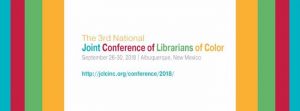The Ultimate Team Project: Presenting at a Library Conference
by Sara Kelso
If you are a library student or a newly minted MLIS-degreed, bonafide “master of library and information science,” you have probably given some thought to what comes next in your career pursuits. It is possible you already follow blogs and listservs, read journals, have a LinkedIn profile, and are out there networking to light that fire and shine among the competition. If you have ever read the interviews of hiring staff at the popular library blog, Hiring Librarians, you have probably also heard that employers want a few key things from graduates upon entering the job market: real-world experience (or at the very least, volunteer experience or an internship in a library, information, or archive setting), a published work, and a professional presentation under your belt. Depending on your focus in the library world, there may be more or less emphasis on some of these desirables, but employers are looking for people who can back up the theory learned in the classroom, and whose work demonstrates passion, intellectual capability, and a strong sense of where the library world is, where it is going, and how to navigate the landscape along the way.
Presenting at a conference might be easier than you think, and while daunting beyond belief for those of us who are new to the profession or still in school, there are ways to make it less terrifying. Taking the leap by putting yourself out there is a risk, true, but you will never know until you try, and there are more opportunities out there to share your voice with library folks than you might imagine. Not only is a conference presentation a great addition to your portfolio or resume, it is an opportunity to engage with the broader library community. Teaming up with other colleagues who share similar perspectives and attitudes on particular library issues or trends can make this an even easier and more rewarding experience, not to mention a great opportunity for networking.
Here’s how the editorial team for the Student Research Journal (SRJ), at San José State University’s iSchool did it:
Get started early. This might be a no-brainer, but the more time you have to plan, the better your presentation will ultimately be. The SRJ team had a slight advantage because the Library 2.014 Conference, a global virtual worldwide conference focusing on technology and communication, was spearheaded by San José State University; early on, we knew about the event, courtesy of our faculty advisor to the scholarly journal, Dr. Anthony Bernier. Many conferences require that participants submit proposals months in advance, along with choosing a time slot weeks ahead once the proposal is approved. So how do you find out about these conferences and how to contribute?
Do your research. Decide what you want to talk about, and then decide what the best forum is for your topic. Is it time-sensitive and representative of current or future trends? Is it focused on public libraries, academic libraries, technology, government documents, or archival information? Match your discussion to a relevant audience. Again, maybe this is a no-brainer, but many conferences have themes; and they only accept proposals that fit within that scope.
To find out what’s happening at the ALA national level, check out their Conferences & Events page. For a more regional calendar, try Douglas Hasty’s Library Conference Planner. Connect with your state library association too. Most will list upcoming conferences at the state level and for various divisions.
Coordinate with others. Does presenting alone seem daunting? Consider teaming up with other colleagues who can contribute to the project and divide up the work. After all, two heads are better than one, as the old saying goes. Now those of us who have been through library school know that the idea of a “team project” can evoke nightmarish memories from bad experiences. Consider presenting at a library conference the opportunity for the ultimate team project, but one in which everyone will be more likely to contribute. Why? Because presenting publicly is a big deal, and a reflection on professional competency. If people aren’t genuinely interested in sharing a passion for libraries, it will be pretty evident right away. To encourage everyone to contribute equally, make it easy: designate someone who can act as a coordinator or de facto leader for the project to keep everyone on schedule; and then, if crazy schedules (and different time zones, as was the case for us) become a factor, consider making a shared document in the cloud everyone can access and edit. Designate roles and tasks early on so everyone knows who is responsible for what. Solicit your team members for good times to meet to regularly, check in on goals, and progress. Communicate, communicate, communicate!
Submit your proposal! Somewhere early on in the planning stages, most library conferences will ask for a proposal to make sure the best topics and presenters are selected for their limited time slots, and to make sure the conversations at the conference are truly interesting and relevant. Once you have got an idea about what your topic will entail, where you want to present, and who will be involved, draft up a proposal to submit. Guidelines will vary depending on the organization; just follow the instructions to include all of the information asked of you. For the Library 2.014 conference, presenters were required to send in a proposal that identified the institution, presenters, a short summary of the proposed presentation, a detailed summary, and the relevance to the conference.
Stay on track. With months often in between having a proposal submitted and the actual conference, it can be easy to let these “extracurricular” projects take the back burner; do not wait to the last minute to put your presentation together!
Do a dry run ahead of time. Work out the kinks in your technology set up, any typos or formatting issues, the timing, flow, focus, and feel of your presentation to make sure it meets conference standards by practicing ahead of time. For SRJ, we knew this meant our presentation had to work seamlessly in an online collaborative meeting space where slides, chat messaging, audio, and video had to be coordinated smoothly for six different presenters in a single group. Additionally, our presentation had to follow specific guidelines for length, allow time for questions and answers, and it had to start right on time, creating lots of room for things to go wrong with that many factors at play. You do not want to be lax about things you think will be simple; they never are!
Go out there and slay ‘em. You’ve done months of preparation, you got yourself on the conference circuit, your presentation is polished and your team is revved up and ready–now go out and share your work with the world! It is normal to be a bit nervous, or ok, even super nervous, but by now, you are beyond ready. Go burn off a bit of that excess energy and take a walk around the block before your big moment, then breathe deeply, and get in there. Congrats! You’ve made it through your first library conference. Pat yourself on the back, think about what you can improve for next time, and start thinking about the next big event!
Check out the recording for our presentation, Get Published! The Best Advice for Students Submitting to Peer-Reviewed Journals here, and find out more about the Library 2.014 conference here.
Sara Kelso is an adult services librarian working in a public library near Portland, Oregon. She is an active member of her state library association, and she has served as the editor for the Oregon Library Association Quarterly Journal for two years. She also volunteers with Answerland, a statewide chat-based virtual reference service that assists patrons throughout Oregon and beyond. Sara is the current Managing Editor for the Student Research Journal, San Jose State University iSchool. Fall 2014 is her last semester in the SJSU program.


